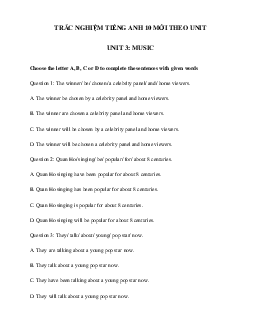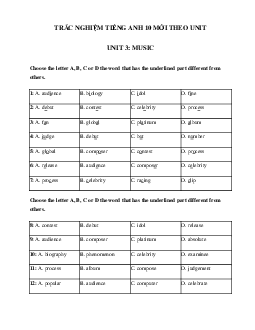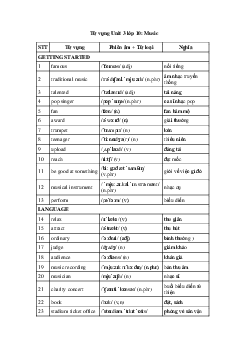





Preview text:
Soạn Unit 3 Lớp 10: Project trang 37
Traditional Music (Âm nhạc truyền thống)
Work in groups. Do a research on a form of traditional music in Viet Nam or
another country. Present your findings to the class. Your presentation should include:
(Làm việc nhóm. Làm một nghiên cứu về một loại hình âm nhạc truyền thống ở Việt
Nam hoặc một quốc gia khác. Trình bày kết quả của bạn trước lớp. Bài thuyết trình của bạn nên bao gồm)
• when/ where it started (bắt đầu ở đầu/ khi nào)
• instrument(s) (nhạc cụ) • types (loại)
• artists/ performers (nghệ sĩ / người biểu diễn) • costumes (trang phục) Example: (Ví dụ) Xoan singing (Hát xoan)
1. Where it started: Phu Tho (Nơi bắt đầu: Phú Thọ)
2. Instrument(s): drum, clappers (Nhạc cụ: trống, phách) 3. Types: 3 (Loại: 3) Gợi ý đáp án Xam singing (Hát xẩm)
1. When it started: the 14th century
(Thời gian bắt đầu: thế kỷ 14)
2. Instrument(s): monochord, two-chord fiddle, drum, clappers
(Nhạc cụ: đàn bầu, đàn fiddle hai hợp âm, trống, phách) 3. Types: 2 (Loại: 2)
4. Costumes: dark clothes, especially brown
(Trang phục: quần áo tối mào, đặc biệt là màu nâu) Gợi ý mẫu 1
We did research on a form of traditional music in Viet Nam which is xam singing. It is
a type of Vietnamese folk music which was popular in the Northern region of Vietnam
but is nowadays considered an endangered form of traditional music in Vietnam. The
origin of xam singing was dated from the Tran dynasty in the 14th century. Xam
artists often play monochord or two-chord fiddle to accompany the songs themselves,
and sometimes they form a band with one singer and others who play traditional
instruments such as the drum or clappers. If you search on the Internet, there are many
different types of xam singing. However, depending on the rhythm of the drum, xam
singing is divided into two styles, xam cho for a rapid rhythm and xam co dao for a
slow one. About the costumes of xam performers, they often wear dark clothes,
especially brown ones. After getting such information about xam singing, we hope
that all of you will try listening to this type of music Tạm dịch:
Chúng tôi đã nghiên cứu về một loại hình âm nhạc truyền thống của Việt Nam, đó là
hát xẩm. Đây là một loại hình âm nhạc dân gian Việt Nam phổ biến ở khu vực phía
Bắc Việt Nam nhưng ngày nay được coi là một loại hình âm nhạc truyền thống có
nguy cơ tuyệt chủng ở Việt Nam. Nguồn gốc của hát xẩm có từ thời Trần thế kỷ 14.
Nghệ nhân Xẩm thường chơi đàn bầu hoặc đàn nhị để đệm cho các bài hát, đôi khi họ
thành lập ban nhạc với một ca sĩ và những người khác chơi các nhạc cụ dân tộc như
trống hoặc phách. Nếu bạn tìm kiếm trên Internet, có rất nhiều kiểu hát xẩm khác nhau.
Tuy nhiên, dựa vào nhịp trống thì xẩm được chia thành hai kiểu, xẩm chợ cho nhịp
nhanh và xẩm cô đào cho nhịp chậm. Về trang phục của người diễn xẩm, họ thường
mặc đồ sẫm màu, đặc biệt là màu nâu. Sau khi biết được những thông tin như vậy về
hát xẩm, chúng tôi hy vọng rằng tất cả các bạn sẽ nghe thử thể loại nhạc này. Gợi ý mẫu 2
Vietnam's traditional culture has many musical genres that are loved by many people,
even recognized by UNESCO as a cultural heritage. If the North has love-filled quan
ho folk songs, While the Central region has passionate songs, in the South, people can
get excited when they hear the cai luong songs imbued with love for the land and
people. When it comes to reforming, no one is a stranger. Cai Luong is a folk song of
the Southern people. It is a type of theater and theater formed on the basis of folk
music and folk songs in the Mekong Delta. Cai Luong understood in the sense from
Sino-Vietnamese means "modification for the better". Based on the principles and
foundations from the previous traditional singing style, a new folk tune, a new
traditional stage has been formed with a bolder impression of the Southern people. Cai
Luong is famous, but its history and origin are still the subject of debate of many
famous scholars. Some people believe that cai luong originated and took shape in the
early years of the twentieth century, from 1916 or 1918. Thus, cai luong was born and
flourished in the early years of the second century. ten years and handed down to the
present day. Cai Luong has entered the spiritual life of the people of the South in
every song, every song, and each other. It has become an indispensable spiritual dish
of the people of the South. Traditional theater art - cai luong is so famous, but what
are the characteristics of cai luong, few people can understand. Can be seen anywhere
in Southern Vietnam, a couple of three sentences of Cai Luong echoing up. But in
order to understand the meaning of each word, as well as how to use words, set up
stage, and topic, it is difficult for us to grasp. In Cai Luong, the beginning of Cai
Luong's wealth is the spoken plays with the direction of the verses of the Boi singing
and the stage of the Southern singing. But gradually, from the first plays with the
layout from ancient tales, old stories, cai luong has had its own unique stage with
opening, closing and action progressions. of drama. It was these things that stimulated
the development of the cai luong theater stage from the very beginning. Tạm dịch
Nền văn hóa truyền thống Việt Nam có rất nhiều thể loại âm nhạc được rất nhiều
người yêu thích, thậm chí còn được UNESCO công nhận là di sản văn hóa.Nếu như
miền Bắc có những làn điệu dân ca quan họ trĩu nặng tình yêu, miền Trung có những
câu hò nghe tha thiết, thì ở miền Nam, người ta lại có thể rạo rực trong lòng khi nghe
tới những câu cải lương thấm đẫm tình đất và người. Nói tới cải lương, hẳn không ai
còn xa lạ. Cải lương là một làn điệu dân ca của người Nam Bộ. Nó là một loại hình
kịch hát được hình thành trên cơ sở của nhạc đờn ca tài tử và dân ca miền đồng bằng
sông Cửu Long. Cải lương hiểu theo nghĩa từ Hán Việt có nghĩa là "sửa đổi để cho tốt
hơn". Chính dựa trên những nguyên tắc và cơ sở từ lối hát truyền thống trước, đã hình
thành nên một làn điệu dân ca mới, một sân khấu truyền thống mới in đậm hơn dấu ấn
của người Nam Bộ. Cải lương nổi tiếng là thế nhưng lịch sử và nguồn gốc ra đời của
nó vẫn còn là đề tài tranh luận của nhiều học giả nổi tiếng. Có người cho rằng, cải
lương xuất phát, manh nha từ những năm đầu thế kỉ hai mươi, từ những năm 1916
hoặc 1918. Cứ thế, cải lương ra đời và phát triển một cách hưng thịnh trong những
năm đầu của thế kỉ hai mươi và lưu truyền tới tận bây giờ. Cải lương đã đi vào đời
sống tinh thần của người dân Nam Bộ trong từng câu hát, từng điệu hò đối đáp nhau.
Nó đã trở thành một món ăn tinh thần không thể thiếu của người dân Nam Bộ.Nghệ
thuật sân khấu truyền thống - cải lương nổi tiếng đến như vậy nhưng đặc điểm của cải
lương là gì thì ít ai có thể hiểu rõ.Chúng ta có thể bắt gặp ở bất cứ đâu đó Nam Bộ đôi
ba câu cải lương vọng lên.Nhưng để hiểu được ý nghĩa của từng câu chữ, cũng như
cách dùng từ, dựng sân khấu, đề tài thì chúng ta khó có thể nắm bắt được hết.Trong
cải lương, cái bắt đầu khởi sự của cải lương là những vở kịch nói mang hơi hướng của
những câu hát bội và sân khấu của hát bội miền Nam. Thế nhưng dần dần, từ những
vở kịch đầu tiên mang bố cục từ những tích cổ, những câu chuyện xưa, cải lương đã
có cho riêng mình một sân khấu đặc trưng với các phần mở màn, hạ màn và tiến triển
theo hành động của kịch. Chính những điều này đã kích thích sự phát triển của sân
khấu kịch cải lương từ những ngày đầu mới chớm. Tóm lại, cải lương có thể dung nạp
bất kì nội dung nào để tạo nên một vở kịch cải lương đặc sắc nhưng không thể thiếu
trong đó là cái chất riêng của người Nam Bộ, cái hồn riêng của nghệ thuật sân khấu
truyền thống được thổi vào đó qua từng câu chữ, từng tiếng hát. Gợi ý 3
- Cải Lương, also known as Vietnamese reformed theater, is a traditional form of
musical theater that originated in Southern Vietnam. It has been an integral part of
Vietnamese culture for over a century and continues to captivate audiences with its
unique blend of music, singing, storytelling, and vibrant performances.
- Cải Lương combines elements of traditional folk music, classical opera, and modern
influences to create a distinct art form. It emerged in the early 20th century as a result
of the fusion between the traditional Vietnamese opera (Hát Bội) and French theatrical
styles brought by colonial influences.
- The performances of Cải Lương are characterized by the use of vibrant costumes,
elaborate makeup, and intricate stage settings. The actors, known as "đầu bè" or "nghệ
sĩ," skillfully portray various characters through their gestures, expressions, and vocal
techniques. The music in Cải Lương is accompanied by traditional instruments such as
đàn tranh (16-string zither), đàn nguyệt (two-string moon lute), and đàn nhị (two- string fiddle).
- The stories depicted in Cải Lương often revolve around historical events, legends, or
moral lessons. They touch upon themes of love, loyalty, patriotism, and social issues,
reflecting the values and traditions of Vietnamese society. The dialogues are delivered
in a poetic and rhythmic manner, blending spoken word with melodic singing.
- Cải Lương has played a significant role in preserving and promoting Vietnamese
cultural heritage. It has evolved over time, adapting to changing tastes and
incorporating modern elements to appeal to younger audiences. Despite facing
challenges from other forms of entertainment, Cải Lương continues to thrive and
attract both traditional and contemporary theater enthusiasts.
- In recent years, efforts have been made to revive and promote Cải Lương through
festivals, competitions, and educational programs. Many talented artists and troupes
have emerged, ensuring the continuity and development of this cherished art form.
- Cải Lương holds a special place in the hearts of Vietnamese people, serving as a
source of entertainment, cultural pride, and a means of connecting generations. It
showcases the rich artistic traditions of Vietnam and serves as a reminder of the
country's history and identity.




